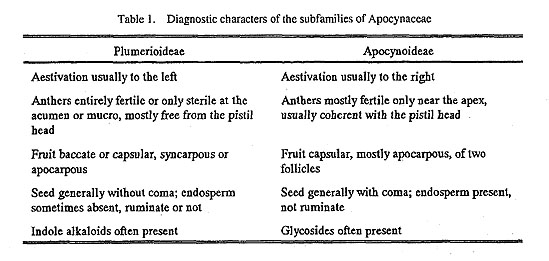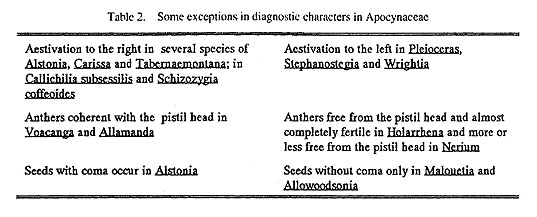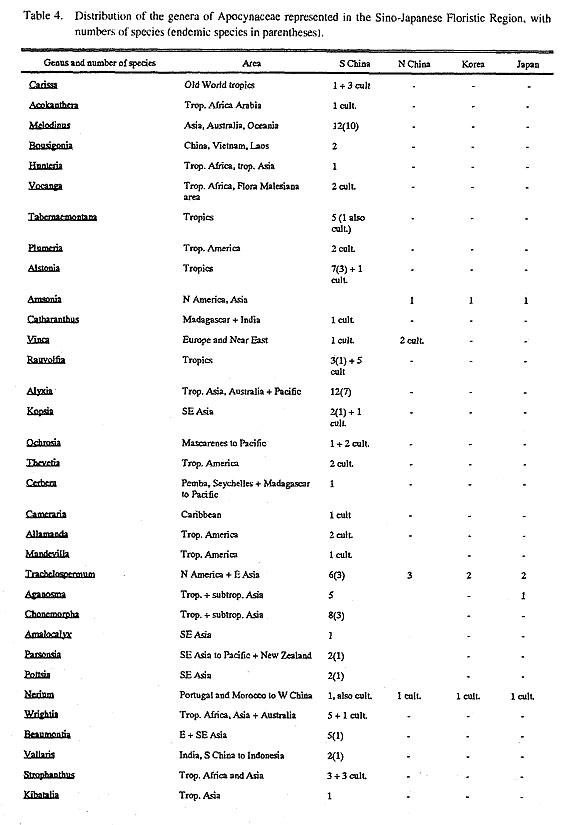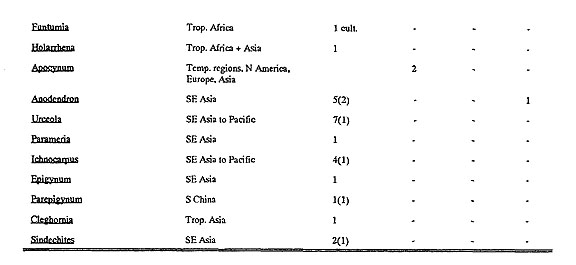The Apocynaceae in the Sino-Japanese Floristic Region
A. J. M. Leeuwenberg
Department of Plant Taxonomy, Agricultural University, P.O.B. 8010 6700 ED. Wageningen. The Netherlands
|
Abstract. The Apocynaceae, a mainly tropical family, are well represented in southern China, especially in Yunnan. The few representatives in northern China, Korea and Japan are almost exclusively from genera of temperate regions. The family is of great medicinal interest. Key words. Apocynaceae, distribution, classification, China, Japan, Korea The Apocynaceae belong to the order Gentianales where they could be considered intermediate between the relatively primitive Loganiaceae and the advanced Asclepiadaceae. Particularly the floral characters are indicative of this placement. There is no connection between the stamens and the pistil in the Loganiaceae, while the stamens are completely fused with the pistil in members of subfamily Asclepioideae of the Ascle piadaceae. In several genera of Apocynaceae, e. g. in the Carisseae, for instance in Carissa (Old World) and Clitandra (Africa) the stamens develop independently from the pistil, while in most genera they cover the pistil head with the anthers. In several genera, almost all of which belong to subfamily Apocynoideae, they are even coherent with the pistil head. The family is also related, but not so strongly, to the Rubiaceae, which was placed in the Gentianales by Wagenitz (1964) who discussed the relationship of the Rubiaceae with Loganiaceae. The Apocynaceae number 155 genera and about 1700 species, which are almost equally shared by the two subfamilies, Apocynoideae and Plumerioideae. Previous authors recognized a larger number of genera, but within the past few years the number has been reduced by P. T. Li (IBSC), D. J. Middleton (TCD) and Leeuwenberg (WAG), some of which have been mentioned in recent papers (see references) and others toappear in forthcoming publications. The family is easily recognized by the opposite leaves, the white latex and the sympetalous actinomor phic flowers with contorted aestivation (but see Table 2 for taxa with exceptional characters). The family also is well known for the numerous medicinal plants it contains, e.g. in the genera Rauvolfia, Strophanthus, Tabernaemontana and Voacanga. The features distinguishing the two subfamilies are shown in Table 1. Table 3 provides a survey of subfamilies, tribes and genera in Apocynaceae.
In China 44 genera are represented, 34 in the wild and 10 exclusively in cultivation. Three genera (of which 2 occur in the wild) are known from Korea, and 5 genera (of which 4 occur in the wild) occur in Japan. The three countries contain 112, 3 and 5 species in the wild and 39, 1 and 2 species in cultivation, respectively (Table 4). The cultivated species are grown mainly for their medicinal properties. Some species are beautiful ornamentals.
The areas of distribution of most genera are mainly within the tropics. Some species reach southern China. Many species of Apocynaceae are represented in China only in southern Yunnan, especially in Xishuangbanna. These species have areas either covering southeastern continental Asia, the whole of conti nental tropical Asia, one of the two portions of Asia mentioned plus the area of the Flora Malesiana, or finally all tropical Asia plus tropical Australia and/or Oceania. The most widespread genera are Alstonia, Rauvolfia and Tabernaemontana, which are represented all over the tropical belt, but their species are endemic to only one part of the world, except for those repre sented in Asia and Australia. Carissa, Cerbera, Holarrhena, Hunteria, Ochrosia, Strophanthus and Wrightia are found throughout most of the tropical belt of the Old World, and are therefore also repre sented in Africa. Carissa, Cerbera and Ochrosia also occur in Australia and Oceania. There they are accompanied by Alyxia, Melodinus and Parsonsia. Parsonsia is even known from New Zealand. The smallest distributional areas of species represented just outside China are in the tropical genera Amalocalyx and Bousigonia, counting one and two species respectively, in the countries bordering Yunnan. The monotypic genus Parepigynum is restricted to China. Some 35 species scattered over many genera are endemic to China, but no species are endemic to either Korea or Japan. The number of species, especially those formerly thought to be endemic, has decreased as the genera in which they occur have been monographed and revised, for example, in the treatments of Ichnocarpus and Tabemaemontana. Similar reductions are to be expected in other genera, for instance in Alyxia and Melodinus (with 6 and 9 species endemic to China), which are in urgent need of revision. The fact that the family has so few endemic representatives in China, Korea and Japan is not surprising, since the countries are at the edge of the main range of distribution of most of the genera occurring there. The genera represented outside the tropical belt have various areas of distribution. The monotypic genus Nerium extends from Portugal and Morocco in the west to western China in the east Trachelospermum has one species in North America, seven in Central China, two in Korea and two in Japan, and a few in coun tries south of China. Amsonia has almost all of its species in North America, but one, A. orientalis, is known only from northwestern Turkey and another, A. elliptica, occurs in China (in Anhui and Jiangsu provinces), Korea and in Japan. The type genus for the family, Apocynum, includes seven species in North America and two in the Old World. One of them, A. pictum is in central Asia and in China is in Gansu, Qinghai and Xinjiang provinces. The other, A. venetum, has one of the largest areas of distribution of any species of the family, extending from eastern Europe and Turkey eastward to China, Siberia, Mongolia and Japan. The genera indigenous in Japan are distributed as follows: Amsonia in Hokkaido, Honshu and Kyushu; Trachelospermum extending from Honshu to the Ryukyus; Anodendron in southern Honshu and south to the Ryukyus; and Apocynum in Hokkaido and northern Honshu.
|




